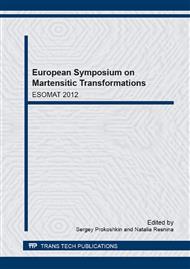[1]
L. Yahia (Ed. ), Shape memory implants, Springer, Verlag-Berlin-Heidelberg-NewYork, (2000).
Google Scholar
[2]
A. Kapanen, A. Danilov, P. Lehenkari, J. Ryhanen, J. Tuukkanen, Effect of metal alloy surface stresses on the viability of ROS-17/2. 8 osteoblastic cells, J. Biomaterials 23 (2002) 3733-40.
DOI: 10.1016/s0142-9612(02)00107-2
Google Scholar
[3]
V. Muhonen, Bone – biomaterial interface. The effects of surface modified NiTi shape memory alloy on bone cells and tissue, Acta Universitatis Oulensis D974, University of Oulu, 2008. Available online at: http: /herkules. oulu. fi/isbn9789514288340.
Google Scholar
[4]
V. Muhonen, R. Heikkinen, A. Danilov, T. Jamsa, J. Ilvesaro, J. Tuukkanen, The phase state of NiTi implant material affects osteoclastic attachment, J Biomed Mater Res 75A (2005) 681-688.
DOI: 10.1002/jbm.a.30477
Google Scholar
[5]
C.M. Wayman, Introduction to crystallography of martensitic transformations, MacMillan, New York, (1964).
Google Scholar
[6]
A.N. Danilov, A.I. Razov, Determination of B19¢- martensite volume fraction in nickel-titanium alloys by x-ray diffraction, Physics of Solid State 53 7 (2011) 1378-1381.
DOI: 10.1134/s1063783411070067
Google Scholar
[7]
A.N. Danilov, A.I. Razov, X-ray determination of stresses in medical constructions of nickel-titanium alloys by extrapolation method, Material Science 6 (2011) 29-31.
Google Scholar
[8]
S. Miyazaki, K. Otsuka, Y. Suzuki, Transformation Pseudo-Elasticity and Deformation-Behavior in a Ti-50. 6 at-Percent Ni-Alloy, Scripta Metallurgica 15 (1981) 287-292.
DOI: 10.1016/0036-9748(81)90346-x
Google Scholar
[9]
K. Madangopal and J. Singh, A Novel B19' Martensite in Nickel Titanium Shape Memory Alloys, Acta Mater. 48 (2000) 1325–1344.
DOI: 10.1016/s1359-6454(99)00423-1
Google Scholar
[10]
K. Otsuka, T. Sawamura, K. Shimizu, Crystal structure and internal defects of equiatomic TiNi martensite, Phys. Stat. Sol. A 5 (1971) 457-470.
DOI: 10.1002/pssa.2210050220
Google Scholar
[11]
K. Otsuka, X. Ren, Physical metallurgy of Ti–Ni-based shape memory alloys, Progress in Materials Science 50 (2005) 511–678.
DOI: 10.1016/j.pmatsci.2004.10.001
Google Scholar
[12]
O.T. Fackler, R. Grosse, Cell motility through plasma membrane blebbing, J Cell Biol. 181 (2008) 879–884.
DOI: 10.1083/jcb.200802081
Google Scholar
[13]
L. Normana, K. Senguptab, H. Aranda-Espinozaa, Blebbing dynamics during endothelial cell spreading, European Journal of Cell Biology 90 (2011) 37–48.
DOI: 10.1016/j.ejcb.2010.09.013
Google Scholar
[14]
J-Y. Tinevez, U. Schulze, G. Salbreux, J. Roensch, J-F. Joanny, and E. Paluchab, Role of cortical tension in bleb growth, Proc Natl Acad Sci U S A. 106 (2009) 18581–18586.
DOI: 10.1073/pnas.0903353106
Google Scholar
[15]
J. C. Millsa, N. L. Stoneb, R. N. Pittmanb, Extranuclear Apoptosis. The Role of the Cytoplasm in the Execution Phase, JCB 146 (1999) 703-708.
Google Scholar
[16]
M. L. Coleman, M. F. Olson, Rho GTPase signalling pathways in the morphological changes associated with apoptosis, Cell Death & Differentiation 9 (2002) 493-504.
DOI: 10.1038/sj.cdd.4400987
Google Scholar
[17]
S. Elmore, Apoptosis: A Review of Programmed Cell Death, Toxicol Pathol 35 (2007) 495-516.
DOI: 10.1080/01926230701320337
Google Scholar
[18]
N. D. Gallant, K. E. Michael, A. J. Garcı´a, Cell Adhesion Strengthening: Contributions of Adhesive Area, Integrin Binding, and Focal Adhesion Assembly, Molecular Biology of the Cell 16 (2005) 4329–4340.
DOI: 10.1091/mbc.e05-02-0170
Google Scholar
[19]
M. Yoshigi, L. M. Hoffman, C. C. Jensen, H. J. Yost, M. C. Beckerle, Mechanical force mobilizes zyxin from focal adhesions to actin filaments and regulates cytoskeletal reinforcement, JCB 171 (2005) 209-215.
DOI: 10.1083/jcb.200505018
Google Scholar
[20]
A.J. Putnam, J.J. Cunningham, B.L. Pillemer, D.J. Mooney, External mechanical strain regulates membrane targeting of Rho GTPases by controlling microtubule assembly, AJP Cell Physiol 284 (2003) 627-639.
DOI: 10.1152/ajpcell.00137.2002
Google Scholar


